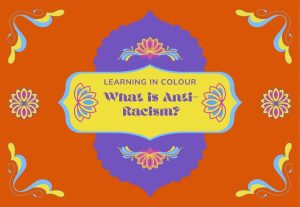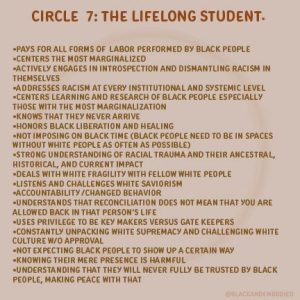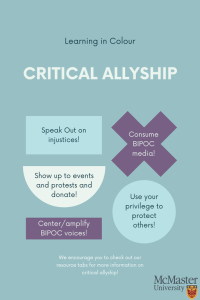14 What Is Anti-Racism?

Being anti-racist results from a continuous and conscious decision to make frequent, consistent, and equitable choices that require levels of ongoing self-awareness and self-reflection.
In the absence of anti-racist choices, there is the ability to consciously and unconsciously uphold aspects of white supremacy, white-dominant culture, and inequitable institutions.
So anti-racism is not just about who you are, but it is also about what you do! It is important to recognize that, due to the breadth and depth of racism, committing to anti-racism can feel overwhelming; however, know that small, daily choices can lead to big changes. Ask yourself: what choices do I make in my daily life that contribute to anti-racism? Some great resources to explore are: The Equality Institute’s Anti-Racism Resource and The National Museum of African American History and Culture’s Anti-Racism Resource.
- At the individual and interpersonal level, being anti-racist involves becoming actively conscious about race and racism while taking actions to end racial inequities in your daily life. This requires believing that racism is EVERYONE’S problem and knowing you have an integral role to play in stopping it. This includes but is not limited to: acknowledging and understanding your privilege, working to change the internalized racism and racist ideologies that you may hold, and interrupting racism when you are identifying it around you. Exploring your own bias is a great place to start.
- Developing a strong “questioning” frame of mind is consistent with exploring anti-racist work in interpersonal encounters. Whether the racism witnessed in interpersonal interactions is obvious or covert, there are opportunities to respond and interrupt it by asking questions! Asking questions can be a powerful tool to seek clarity and offer new perspectives. Seeking clarity, offering alternative perspectives, speaking your truth, finding common ground, and setting boundaries often result from a curious mind. Here are some useful tools derived from the National Museum of African and American History and Culture that can help you to challenge racism in a respectful and intentional way:
- Seek clarity: “Tell me more about __________.”
- Offer an alternative perspective: “Have you ever considered __________.”
- Speak your truth: “I don’t see it the way you do. I see it as __________.”
- Find common ground: “We don’t agree on __________ but we can agree on __________.”
- Give yourself the time and space you need: “Could we revisit the conversation about __________ tomorrow?”
- Set boundaries. “Please do not say __________ again to me or around me.”
- It is important to note that asking these questions might be context-dependent. Consider your own safety and the safety of racialized students in the room before you continue a dialogue that is unsafe or has the potential to become unsafe. While challenging racist rhetoric in the classroom is an important action for anti-racist allyship, it should be done in a way that respects and honours racialized folks and their experiences. You should consider the following:
- Do I have something helpful to contribute to this discussion that will not further unsafe or racist class dialogue?
- If I ask a question, could it be interpreted as creating more space for racist or harmful rhetoric?
- If I ask a question, will it inadvertently burden, tokenize, or put racialized students in the room on the spot with having to educate the class?
- If I intervene, might I be putting racialized students in the room at risk?
- Will my attempts to intervene as a white student escalate the discussion in an unsafe way?
- Will my attempts to intervene as a white student be perceived by racialized students as talking over/interrupting them?
- Will my contribution move class discussion in a safer direction?
As you practice, take note of your responses and ask: How am I processing the experience? What bodily sensations do I have? What is my emotional reaction? Notice what triggers your response and how it might help you understand what anti-racism can look like in practice.
At the institutional level, racism proliferates in policies and practices within institutions that benefit white people and disadvantage people of colour. Advocating for anti-racist education is a starting place to change the discourse and the climate of an institution you may be working within; this allows for a critique and challenge of institutional racism. It can address how racist beliefs and ideologies structure one-on-one and personal interactions within institutions and can examine and challenge how institutions support and maintain disadvantages and advantages across racial lines. Doing this in a reflective and interactive way that allows you and others to reflect on policies, name the racism, discuss what is found, and plan tangible actions can help push anti-racism into institutional and structural planes.
However, it is important to note that anti-racism and the actionable items behind it are inextricably bound to critical allyship; check out the next tab to explore more.
Defining Critical Allyship
Being an “ally” has become a bit of a buzzword! While its uptake in popularity is not necessarily a bad thing, non-racialized folks have often misidentified and misplaced the word while actively engaging in and upholding racism and racist discourse and action. Critical allyship is underpinned by anti-racist work and ideology and, as we mentioned, is a lifelong continuous process of supporting, advocating for, acknowledging, and hearing communities and peoples of colour.
“The 7 Circles of Whiteness” by Alishia McCullough
A great interrogation into your allyship is to examine your own whiteness and how you take it up. Originated by Alishia McCullough, the 7 Circles of Whiteness categorizes expressions of whiteness in an effort to help you interrogate and reflect on ideologies and actions that may be reflective of racism or may be reflective of allyship. We encourage you to explore what circle of whiteness you belong to and how you are working your way into a circle of whiteness that is the lifelong student.
Folks who consider themselves allies are often stuck in circle 5 and 6; circle 7 involves a direct and interrogative process that can be uncomfortable and destabilizing, yet liberating. Some tactics to work towards circle 7 can be:
- Say something! Use your platform and the conversations that you have in your workspace and community as a place to discuss racial issues. Keep these conversations going daily until there is justice.
- Show up! Attend protests, community events, and other anti-racist events that are happening near you (or across the world!). However, avoid sharing images of peoples protesting without their consent; it can be unsafe for people of colour and is not a form of allyship. Sometimes allyship comes without recognition or praise.
- Use your privilege to protect others. Stand on the frontlines, protect the folks around you, and share/shift opportunities to people of colour when you can.
- Sign petitions and demand change for people of colour: write to your local government or school, call out brands and organizations that have stayed silent, etc. Be relentless.
- Call out inaction: call out friends, colleagues, brands, influencers, and governments. EVERYONE should be engaged in this work.
- Donate, if you are in a position to do so: use your money to support people of colour and racialized organizations and businesses; their progression and prosperity breaks down the disproportions and disadvantages of white supremacy.
- Be accountable when you misstep or make a mistake; apologize genuinely and commit to tangible actions and changes.
- Commit to going anti-racism work–continuously look to understand your privilege and complicity in the system, develop a thorough understanding of what racism means and how it affects people of colour, and develop strategies for the ways that you can use your power to create change.
- Centre and amplify voices of colour; try not to speak over them. Amplify their voices and give them space, whether it be in person or online. Share their work and credit them when you do. Do not ask them to do the work for you; do your own research, google things, and educate yourself
- Consume media by people of colour: follow activists online, diversify your news and media outlets, and engage with films, TV shows, books, and articles created by people of colour
- Use your money to support businesses of colour; put your money where your politics are; do the research to find businesses or modalities that directly support the community
- Do these things ALWAYS, not just now; the work does end when the hashtag is no longer trending and the news stop reporting; for people of colour, racism is an everyday reality of living not just brief moments of reported news and instances that others deem worthy of recognition. Commit yourself to doing the work.

A Final Note on Critical Allyship
However, we recognize the road to critical allyship is long and multi-layered. Do not get discouraged if you don’t feel “there yet.” Explore the “Understanding, recognizing, and addressing privilege” tab for some initial steps to begin the development of your anti-racist and critical allyship work, and watch this video.

